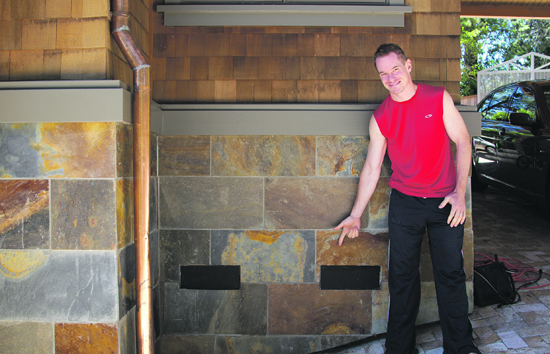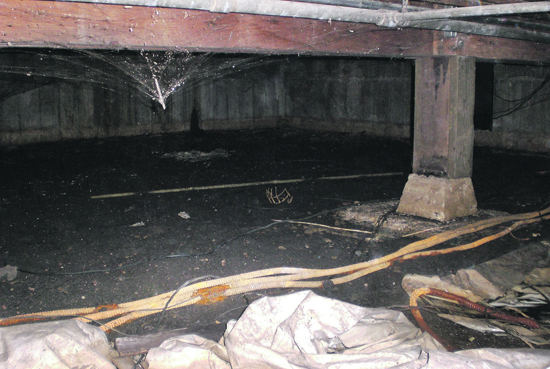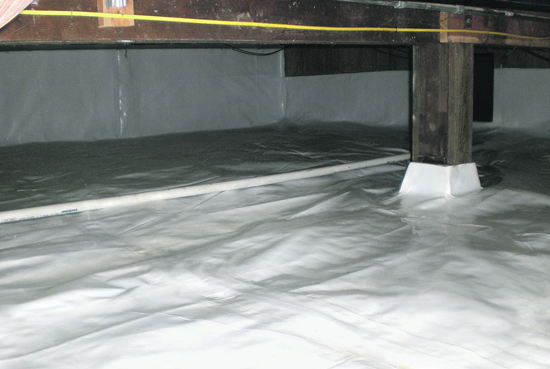 | | | Andy Smith points to the closed vents at his Lafayette home Photo Doug Kohen
| | | | | |
Andy Smith bought a beautiful home in Lafayette's Happy Valley neighborhood, in which solar heaters and electricity generating panels were installed. But it was not enough to completely offset his electricity bill, and more importantly, not enough to be a model of social responsibility for his three young children.
 After the family met with Lafayette architect James Wright, who designed their house for a developer, they discovered that he had designed and was implementing a passive geothermal system to take advantage of the space located under a house. "I grew up in New Jersey," says Smith, "on hot days we used to go to the cellar, which stayed at a cool temperature because it stayed at a constant temperature."
After the family met with Lafayette architect James Wright, who designed their house for a developer, they discovered that he had designed and was implementing a passive geothermal system to take advantage of the space located under a house. "I grew up in New Jersey," says Smith, "on hot days we used to go to the cellar, which stayed at a cool temperature because it stayed at a constant temperature."
 Wright's system does just that - it produces a thermal barrier by sealing the crawl space and creates an air exchange system between the constant-temperature crawl space and the habitat above to cool in the summer and warm in the winter; passive geothermal exchange.
Wright's system does just that - it produces a thermal barrier by sealing the crawl space and creates an air exchange system between the constant-temperature crawl space and the habitat above to cool in the summer and warm in the winter; passive geothermal exchange.
 There are different phases and degrees to which the system can be implemented. At the Smith's residence, the first low cost phase of the project is already done. For a very small investment, the vents of the crawl space were sealed this summer so hot air does not get in, minimizing the need to air-condition the home.
There are different phases and degrees to which the system can be implemented. At the Smith's residence, the first low cost phase of the project is already done. For a very small investment, the vents of the crawl space were sealed this summer so hot air does not get in, minimizing the need to air-condition the home.
 The second phase of the project consists of ventilating the crawl space with an Energy Recovery Ventilator (ERV). The ERV transfers the majority of the incoming fresh air temperature to the existing exhaust air, while maintaining the ambient air temperature in the crawl space.
The second phase of the project consists of ventilating the crawl space with an Energy Recovery Ventilator (ERV). The ERV transfers the majority of the incoming fresh air temperature to the existing exhaust air, while maintaining the ambient air temperature in the crawl space.
 In Larkspur, Debra Busse was impacted by a very wet crawl space and decided to have it completely sealed. "I live a block away from the bay on land that would not be buildable today because it's wet land," says Busse, " the space underneath my home was damp with water coming and going with the tide." She asked Bay Area Moisture Control to completely seal the space and as soon as it was done she noticed that the house became warmer. "We even got a letter from PG&E congratulating us on having saved 16% on our gas consumption this winter," adds Busse. During the Bay Area's recent heat wave she observed that her home stayed cool and she attributed it to the sealed basement. "I could feel cool air coming from under the house," she said. "In addition, this system improves the air quality and health of the building's occupants, because it prevents mold spores, decay, elevated radon levels, asbestos deterioration, termite and other health-related pest concerns," adds Wright. In Larkspur, Debra Busse was impacted by a very wet crawl space and decided to have it completely sealed. "I live a block away from the bay on land that would not be buildable today because it's wet land," says Busse, " the space underneath my home was damp with water coming and going with the tide." She asked Bay Area Moisture Control to completely seal the space and as soon as it was done she noticed that the house became warmer. "We even got a letter from PG&E congratulating us on having saved 16% on our gas consumption this winter," adds Busse. During the Bay Area's recent heat wave she observed that her home stayed cool and she attributed it to the sealed basement. "I could feel cool air coming from under the house," she said. "In addition, this system improves the air quality and health of the building's occupants, because it prevents mold spores, decay, elevated radon levels, asbestos deterioration, termite and other health-related pest concerns," adds Wright.
 "My goal is to establish as many case studies as possible, creating overwhelming evidence to qualify the crawl space as a passive geo-exchange energy contribution to home heating and cooling," says Wright. "Ultimately we hope to receive federal tax credits for this geo-thermal application."
"My goal is to establish as many case studies as possible, creating overwhelming evidence to qualify the crawl space as a passive geo-exchange energy contribution to home heating and cooling," says Wright. "Ultimately we hope to receive federal tax credits for this geo-thermal application."
 James Wright will have a display at the upcoming Lafayette Art and Wine Festival. For more information go to netzeroenergyarchitects.com.
James Wright will have a display at the upcoming Lafayette Art and Wine Festival. For more information go to netzeroenergyarchitects.com.

|




